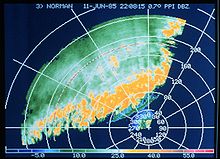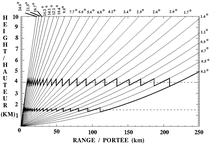31:
134:
43:
214:
82:
sends pulses while rotating 360 degrees around the radar site at a fixed elevation angle. It can then change angle or repeat at the same angle according to the need. Return echoes from targets are received by the antenna and processed by the
237:. However, because the speed of sound in water is very slow compared to microwaves in air, a sonar PPI has an expanding circle that starts with each transmitted "ping" of sound. In meteorology, a competing display system is the
198:. It could store an image for milliseconds to minutes and even hours. One version that kept an image alive about a second before fading proved to be useful for radar. This slow-to-fade display tube was used by
90:
The height of the echoes increases with the distance to the radar, as represented in the adjacent image. This change is not a straight line but a curve as the surface of the Earth is curved and
102:
is usually represented at the top of the image. For moving installations, such as small ship and aircraft radars, the top may represent the bow or nose of the ship or aircraft,
190:, the American inventor of all-electronic television in September 1927, contributed to this in an important way. Farnsworth refined a version of his picture tube (
70:
circles. As the radar antenna rotates, a radial trace on the PPI sweeps in unison with it about the center point. It is the most common type of radar display.
472:
205:
With the development of more sophisticated radar systems, it became possible to digitize data and store it in memory, allowing access at a later date.
46:
Diagram showing the evolution of the height above ground, in kilometers, with the distance to the radar for the 24 PPI angles used on the
Canadian
409:, publié par l'American Meteorological Society, Boston, August 2003. Series: Meteorological Monograph, Volume 30, number 52, 270 pages,
238:
162:
17:
66:
that represents the radar antenna in the center of the display, with the distance from it and height above ground drawn as
114:. Some systems may incorporate the input from a gyrocompass to rotate the display and once again display north as "up".
414:
375:
352:
323:
310:
269:
340:
221:
The PPI is used in many domains involving display of range and positioning, especially in radars, including
467:
184:, and thus the only way to store the information received was by taking a photograph of the screen.
187:
145:. The annotations were added later for post-attack analysis. The Rhine River can clearly be seen.
199:
122:
107:
8:
222:
234:
360:
Le radar, 1904-2004: histoire d'un siècle d'innovations techniques et opérationnelles
30:
435:
410:
371:
348:
319:
306:
265:
154:
191:
181:
150:
125:, so it is possible to have many PPIs at one time, one for each antenna elevation.
84:
241:(Constant Altitude Plan Position Indicator) when a multi-angle scan is available.
334:
79:
462:
391:
387:
166:
456:
407:
Radar and
Atmospheric Science: A Collection of Essays in Honor of David Atlas
226:
95:
63:
47:
195:
174:
118:
276:
34:
Image of a thunderstorm line (in dBZ) seen on a 0.7-degree elevation PPI (
328:
229:, on board ships and aircraft etc. PPI displays are also used to display
111:
280:
67:
279:. There is an open source verification for this text on the home page
133:
399:
170:
138:
382:
A Radar
History of World War II: Technical and Military Imperatives
142:
367:
344:
217:
Simplified animation of a Plan
Position Indicator radar display
158:
42:
363:
249:
245:
230:
194:, or CRT) and called it an "Iatron;" generically known as a
99:
384:, Philadelphia, Pa.: Institute of Physics Publishing, 1999.
110:(direction of travel) and this is usually represented by a
35:
303:
The
Bombers: the RAF offensive against Germany, 1939-1945
213:
149:
The PPI display was first used prior to the start of the
87:
and the most direct display of those data is the PPI.
337:and 40th Anniversary Radar Meteorology Conference
180:Originally, data was displayed in real time on a
454:
252:installations can mimic radar PPI displays too.
161:. The first production PPI was devised at the
473:Meteorological instrumentation and equipment
263:ECHOES OF WAR : The Story of H2S Radar
405:Roger M. Wakimoto and Ramesh Srivastava,
163:Telecommunications Research Establishment
244:Using computers to process data, modern
212:
202:from the very beginning of radar usage.
132:
41:
29:
14:
455:
396:Doppler Radar and Weather Observations
141:PPI display taken during an attack on
117:Also, the signal represented is the
398:, Academic Press. Seconde Edition,
24:
281:Greg Goebel / In The Public Domain
157:experimental radar system outside
25:
484:
169:and was first introduced in the
98:. For fixed-site installations,
341:American Meteorological Society
255:
428:
73:
13:
1:
421:
305:, Hutchins & Co, (1983),
121:at only one elevation of the
7:
296:Bernard Lovell: A Biography
10:
489:
277:Microwave Radar At War (1)
128:
362:, published by Ellipses,
291:- Camb Univ Press - 1948
173:blind-bombing system of
402:Cal., 1993 p. 562.
208:
200:air traffic controllers
188:Philo Taylor Farnsworth
56:plan position indicator
18:Plan-position indicator
333:Radar in Meteorology:
218:
146:
51:
39:
216:
136:
45:
33:
298:- Robert Hale - 1984
233:data, especially in
347:, 1990, 806 pages,
261:Sir Bernard Lovell
225:, ship navigation,
223:air traffic control
137:A photograph of an
27:Radar sweep display
438:. Radartutorial.eu
355:, AMS Code RADMET.
289:One Story of Radar
235:underwater warfare
219:
147:
52:
40:
468:Radar meteorology
16:(Redirected from
480:
447:
446:
444:
443:
432:
417:; AMS Code MM52.
358:Yves Blanchard,
301:Norman Longmate
192:cathode ray tube
182:cathode ray tube
151:Second World War
21:
488:
487:
483:
482:
481:
479:
478:
477:
453:
452:
451:
450:
441:
439:
436:"block diagram"
434:
433:
429:
424:
339:, published by
335:Battan Memorial
294:Dudley Saward,
258:
211:
131:
76:
62:) is a type of
28:
23:
22:
15:
12:
11:
5:
486:
476:
475:
470:
465:
449:
448:
426:
425:
423:
420:
419:
418:
403:
385:
380:Brown, Louis.
378:
356:
326:
313:
299:
292:
285:
272:
257:
254:
210:
207:
130:
127:
75:
72:
50:(curved lines)
48:weather radars
26:
9:
6:
4:
3:
2:
485:
474:
471:
469:
466:
464:
461:
460:
458:
437:
431:
427:
416:
415:1-878220-57-8
412:
408:
404:
401:
397:
393:
389:
386:
383:
379:
377:
376:2-7298-1802-2
373:
369:
365:
361:
357:
354:
353:0-933876-86-6
350:
346:
342:
338:
336:
330:
327:
325:
324:0-7503-0586-X
321:
318:
314:
312:
311:0-09-151580-7
308:
304:
300:
297:
293:
290:
286:
284:
282:
278:
275:Adapted from
273:
271:
270:0-85274-317-3
267:
264:
260:
259:
253:
251:
247:
242:
240:
236:
232:
228:
224:
215:
206:
203:
201:
197:
193:
189:
185:
183:
178:
176:
172:
168:
164:
160:
156:
152:
144:
140:
135:
126:
124:
120:
115:
113:
109:
105:
101:
97:
96:radar horizon
93:
88:
86:
81:
71:
69:
65:
64:radar display
61:
57:
49:
44:
37:
32:
19:
440:. Retrieved
430:
406:
395:
388:R. J. Doviak
381:
359:
332:
316:
315:E. G. Bowen
302:
295:
288:
287:A. P. Rowe:
274:
262:
256:Bibliography
243:
220:
204:
196:storage tube
186:
179:
175:World War II
148:
119:reflectivity
116:
103:
91:
89:
77:
59:
55:
53:
392:D. S. Zrnic
329:David Atlas
227:meteorology
155:Jagdschloss
112:lubber line
74:Description
457:Categories
442:2012-06-08
422:References
317:Radar Days
94:below the
78:The radar
68:concentric
400:San Diego
171:H2S radar
370:, 2004
85:receiver
143:Cologne
129:History
123:antenna
108:heading
80:antenna
413:
374:
368:France
351:
345:Boston
322:
309:
268:
159:Berlin
106:, its
463:Radar
364:Paris
250:lidar
246:sonar
239:CAPPI
231:sonar
153:in a
100:north
92:sinks
411:ISBN
372:ISBN
349:ISBN
320:ISBN
307:ISBN
266:ISBN
248:and
209:Uses
104:i.e.
36:NOAA
390:et
139:H2S
60:PPI
459::
394:,
366:,
343:,
331:,
177:.
167:UK
165:,
54:A
445:.
283:.
58:(
38:)
20:)
Text is available under the Creative Commons Attribution-ShareAlike License. Additional terms may apply.


